Corporate wellness plans seem to be becoming the norm, rather than the exception in the US especially amongst those started in the last 15 years. Once, health insurance was the extent of a company’s wellness plan, now, new employees are expecting healthy meal options, on-site gyms, and other perks to help boost their well-being. With these extra costs and programs, companies are providing them, yet are struggling to understand their exact benefit. Here are a few areas for study that do not usually get factored into the cost analysis.
According to a recent survey of 225 company executives and 653 employees by the Economist Intelligence Unit and sponsored by Humana, ” Measuring Wellness: From data to Insights” executives no longer consider ROI on decreased healthcare costs as the primary driver when considering implementing new wellness plans.
Many executives believe that full cost-benefit justification is neither possible nor necessary. There is broad consensus, however, that better data collection and interpretation would yield more effective programme design and management as well as greater progress towards business goals.
Two thirds of the employees surveyed said they would share more data if they knew that the company was going to use it only for their benefit and 56% said they would share with a 3rd party if their was adequate assurances of confidentiality.
3 Data Points in Analyzing Wellness Programs
Sometimes, it’s the more subtle things that are of the greatest benefit, here are a few of those and how you might track their changes after implementing a wellness program in your company.
1) Increases Presenteeism & Reduces Healthcare Costs
This one is pretty easy to measure, are the employees showing up more frequently after the implementation of the program? The subtlety then lies in what they do when they show up for work? Are they more productive, or are they a walking bio-hazard and feel forced to come in even when they are sick? A study by mixed university and corporate researchers found that corporate wellness programs increase the number of days that people with metabolic syndrome (heart disease diabetes, etc) are present for work and decreased employee-driven healthcare costs by 29%.
2) Improves Office Morale
Besides direct surveys on how people are feeling, a good way to measure this is to see how many complaints, both formally and informally have been received by managers and the HR department. A recent report by the University of East Anglia found that those employees who stopped driving to work and walked or cycled instead saw a great improvement in their overall well-being including being able to handle more stress and directly face problems.
3) Improves Productivity
Continuing on from our previous post that having standing or walking meetings can increase the creativity of ideas generated (and how sitting kills us), wellness programs which include movement throughout the day instead of sitting all day have been shown to decrease fatigue while maintaining productivity. Measure the output of ideas and products from those employees participating in the wellness program and those who are not and you will most likely see a sizable difference in favor of those who are getting sufficient exercise.
Bonus) Improves Mental Health
A very difficult one to measure on its own and even trickier to do from a legal perspective, but exercise has proven itself many times over to have a beneficial effect upon mental health. Researchers in England have found that the saying “just walk it off” may actually be true for dealing with feelings of depression. A simple walk outside helps, done in nature is better, and done in a group seems to be the most effective. While we still do not know exactly what depression is , researchers in Sweden have discovered that a certain muscle protein correlated to a higher KAT enzyme concentration that blocked stress-induced kynurenine from entering the brain and triggering depressive behaviors.
Company wellness programs are a great mechanism to better the lives of employees and make impactful changes to reducing company healthcare costs as well. Many simple measures can be taken to to get started: supporting employees to walk or bike to work (showers and changing rooms), alternate between standing and sitting work stations (normal desks, standing desks/shelves, walking meetings) and decreasing the number of sugar-laden snacks and drinks in the break room or cafeteria. It doesn’t have to be expensive to be effective, so get started and start seeing the benefits today.








